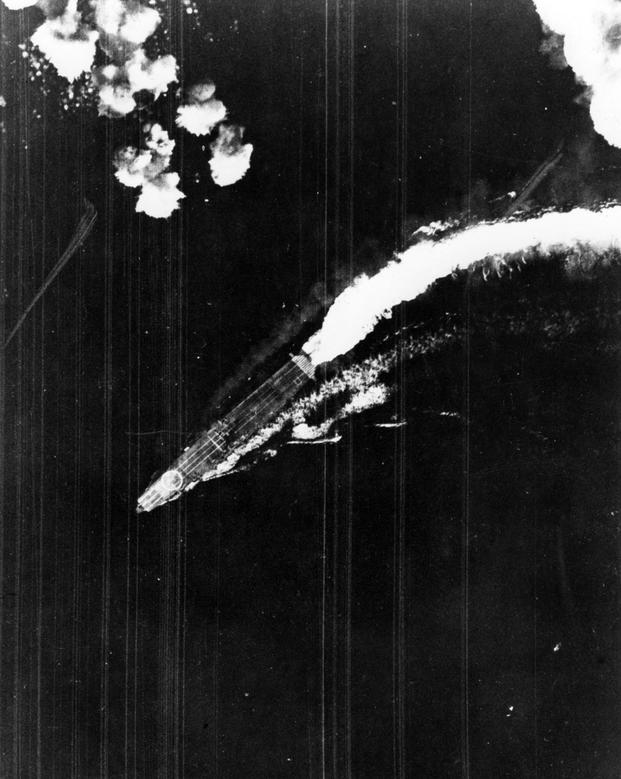During the Battle of Midway, a crippled U.S. Army B-26 bomber flew so close over Japan’s flagship Akagi that its crew believed it was a suicide attack — years before Japan’s own “kamikaze” missions began.
U.S. Army B-26 Bombers at Midway
On the morning of June 4, 1942, four U.S. Army Air Forces B-26 Marauders from the 22nd Bombardment Group, 18th Reconnaissance Squadron, took off from Midway Island. Their mission was to launch Mark 13 torpedoes against the approaching Japanese carrier task force under Vice Adm. Chuichi Nagumo.
The aircraft were designed for tactical bombing missions, not for low-altitude naval attacks with torpedoes. They were also heavily outgunned, outnumbered and were attacking one of the most powerful naval fleets ever assembled. The odds were slim, but the crews volunteered anyway.
Among them was 1st Lt. James P. Muri, pilot of the B-26 “Susie Q.” His crew included 2nd Lt. William W. Moore, bombardier; Sgt. John L. Gogoj, turret gunner; and Cpl. Frank Melo, engineer-gunner. Their mission, part of Midway’s opening strikes, was to distract and delay the Japanese fleet so the American carriers could get their planes into position. The attack would become one of the battle’s most remarkable displays of American courage in the entire war.

Attacking the Japanese Carriers
As the four bombers descended to wave-top height to attack the carrier Akagi, they were intercepted by A6M Zero fighters from the Japanese carriers. Several Army B-17s had already attacked the fleet from a high altitude, failing to score any hits. The Japanese were on high alert.
Anti-aircraft fire from the fleet began to fill the sky. One Marauder was shot down before releasing its torpedo. Muri’s aircraft was hit repeatedly, wounding crewmen and damaging engines and controls, yet he pressed the attack.
Flying at barely 200 feet, Muri released his torpedo at Akagi. The torpedo missed, but the attack forced the flagship to turn sharply to avoid it. Instead of breaking away, Muri continued straight ahead, guiding his crippled aircraft directly along Akagi’s flight deck. His gunners fired as the bomber skimmed the carrier, and Japanese antiaircraft crews hesitated to continue firing for fear of hitting their own ship. Two men aboard Akagi were killed by the strafing run, throwing the crew into fear and confusion.
Another B-26, piloted by Lt. Herbert C. Mayes, came in for another torpedo run but was heavily damaged before it could score a hit. Losing control of the craft, Mayes pressed his controls forward and nearly struck Akagi’s bridge before crashing into the sea.
Japanese officers on the bridge—including Nagumo—reported the American bomber passing so close overhead that they had to duck for cover. This horrified the Japanese. They were taught to believe that the Americans would avoid death at all costs and even flee if given the opportunity. Seeing an American bomber apparently try to intentionally ram into them in a suicidal attack was shocking. That impression, recorded in Japanese after-action reports, contributed to the confusion and tension aboard the flagship as the battle escalated.
Of the four Marauders that took off, two were lost. Muri managed to return Susie Q to Midway with over 500 bullet holes, a shot-off wheel, and damaged propellers. His aircraft was barely flyable, but his entire crew survived.

Turning the Tide in the Pacific
The Army bombers’ attacks, along with similar torpedo runs by U.S. Navy TBD Devastators from the carriers Enterprise, Hornet, and Yorktown, failed to score any major hits. Virtually every single torpedo bomber was shot down by Japanese planes and anti-aircraft fire. It was one of the war’s most courageous sacrifices.
Though they failed in their attack, they accomplished something decisive: they drew Japanese fighters and shipboard guns down to sea level. Japanese crews aboard the carriers had suffered casualties; they were in the process of switching the armament on their planes, and most of their fighters had already sortied out and were not ready for another attack.
When U.S. Navy SBD Dauntless dive bombers arrived minutes later, they found the skies clear above the fleet and the Japanese carriers fully exposed. Within five minutes of beginning their attack, the carriers Akagi, Kaga, and Sōryū were sinking beneath the waves, along with several other Japanese ships. Surviving Japanese sailors now knew the propaganda they had come to believe about the Americans being cowards was far from accurate.
For his actions, Lt. James Muri received the Distinguished Service Cross, and his crew received similar decorations.
The attack by the B-26 crews, though tactically unsuccessful, helped secure victory at Midway. The Japanese fleet was crippled and now knew the Americans were a fighting force willing to sacrifice their lives for their country. The decisive victory at Midway changed the course of the Pacific War and gave the U.S. Navy the initiative going forward.















